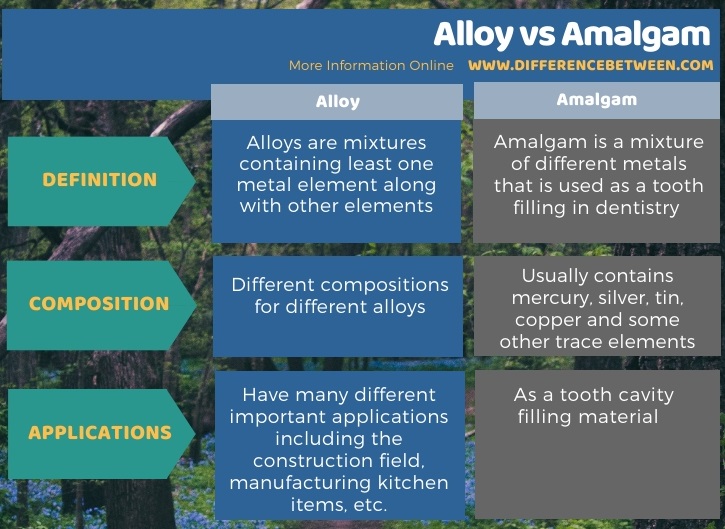Difference Between Alloy and Amalgam
Table of Contents
The key difference between alloy and amalgam is that an alloy contains a combination of metals and nonmetals whereas an amalgam contains a combination of metals.
Both alloy and amalgams are mixtures of different components including metals. They have different uses and different properties as well. Both alloys and amalgam indicate different characteristics than their starting materials.
CONTENTS
1. Overview and Key Difference
2. What is Alloy
3. What is Amalgam
4. Side by Side Comparison – Alloy vs Amalgam in Tabular Form
5. Summary
What is Alloy?
Alloys are metallic compounds. An alloy contains at least one metal element along with other elements. Alloys have improved properties when compared to properties of every single element they are made of. We can obtain these properties by mixing elements in different percentages. Therefore, they give the desired properties by mixing different metals and elements in different amounts. Almost all alloys have a lustre due to the presence of the metal component. Alloys are also able to conduct electricity due to the presence of a metal component.
We can classify alloys in different ways. For example, they can be either homogenous or heterogeneous. Homogenous alloys have components distributed throughout the material uniformly. Heterogeneous alloys, on the other hand, have components distributed in an unorganized manner.

Figure 01: Different Types of Alloys
Furthermore, there are substitutional and interstitial alloys. Substitutional alloys are metal alloys formed from substituting one metal atom for another metal atom of similar size. Interstitial alloys are metal alloys formed by inserting smaller atoms into holes of the metal lattice.
What is Amalgam?
Amalgam is a mixture of different metals that is used as a tooth filling in dentistry. It is the most effective and common tooth filling we use today. Sometimes we call it “silver amalgam” because it appears in silver colour. Generally, this filling material contains liquid mercury and a mixture of metal alloys. We can use it to fill the cavities of the tooth so that tooth decay can be prevented.

Figure 02: Amalgam Filling in Teeth
Generally, amalgam contains mercury (about 50%) along with silver, tin, copper, and some other trace elements. When fabricating this filling, the dentist has to first use a mixing device and mix silver-based alloy and mercury until it gets thoroughly wet. Then, the dentist has to apply this paste into the cavity before it sets. The amalgam usually expands about 0.1% over a time period of 6-8 hours.
What is the Difference Between Alloy and Amalgam?
Both alloy and amalgam are mixtures of different components including metals. The key difference between alloy and amalgam is that an alloy contains a combination of metals and nonmetals whereas amalgam contains a combination of metals. Generally, the amalgam contains mercury, silver, tin, copper and some other trace elements.
Moreover, the alloys have many different important applications including the construction field, manufacturing kitchen items, etc. Meanwhile, the amalgam is used as a tooth filling material to prevent tooth cavities. Dentists make the amalgam mixture at the time where the application is done; they have to mix mercury with a silver-based alloy and apply it in the cavities before setting.
Below infographic summarizes the difference between alloy and amalgam.

Summary – Alloy vs Amalgam
Both alloy and amalgam are mixtures of different components including metals. The key difference between alloy and amalgam is that an alloy contains a combination of metals and nonmetals whereas amalgam contains a combination of metals.
Reference:
1. “Amalgam (Dentistry).” Wikipedia, Wikimedia Foundation, 4 Oct. 2019, Available here.
2. “Alloy.” Encyclopædia Britannica, Encyclopædia Britannica, Inc., 12 July 2019, Available here.
3. Murty, B.s., et al. “A Brief History of Alloys and the Birth of High-Entropy Alloys.” High-Entropy Alloys, 2019, pp. 1–12., doi:10.1016/b978-0-12-816067-1.00001-1.
Image Courtesy:
1. “Alloy atomic arrangements showing the different types” By By Zaereth – Own work (CC0) via Commons Wikimedia
2. “Filling amalgam” By Enzo Carretta – Own work (CC BY-SA 3.0) via Commons Wikimedia
ncG1vNJzZmivp6x7pbXFn5yrnZ6YsqOx07CcnqZemLyue8OinZ%2Bdopq7pLGMm5ytr5Wau26ty6WmsmWRo7Furcyao6CZnWQ%3D